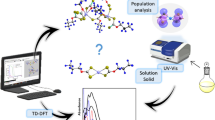Abstract
Theoretical Hartree-Fock, MP2 and density functional (SVWN, BLYP, B3LYP) computations have been first made to calculate the equilibrium geometry and vibration frequencies of CO rhodium(I) chelate dicarbonyl complexes with monocharged bidentate ligands like β-diketonate R1COCHCOR2, iminoketonate R1COCHC(NH)R2, and β-diiminate R1C(NH)CHC(NH)R2 with substituents at carbon atoms R1, R2 = H, CH3, CF3. Consideration of electron correlation was shown to be especially important for the reasonable representation of bond distances with metal atom and CO vibration frequencies. The MP2 computation of exchange-correlation effects, as compared to density functional technique, results in a better description of frequency difference of symmetrical and asymmetrical modes of CO vibrations: inaccuracy in Δν(CO) description recedes from 12–16 cm−1 to 4 cm−1. The dependence between electron density distribution in complexes and spectral characteristics of terminal carbonyl groups was traced. Alteration of CO vibration frequencies was interpreted in terms of electron density shift from occupied d-orbitals of the metal to π*-orbitals of carbonyl groups. Population of CO π *-orbitals increases and CO vibration frequencies decrease on lessening of the electronegativity of donor atoms of a chelate ligand when passing on from oxygen to nitrogen and further among the substituents R CF3>H>CH3.
Similar content being viewed by others
References
C. Masters, Homogeneous Transition-Metal Catalysis:A Gentle Art, Chapman&Hall, London (1981).
A. M. Trzeciak and J. J. Ziolkowski, Coord. Chem. Rev., 190-192, 883–900 (1999).
F. P. Pruchnik, P. Smolenski, and K. Wajda-Hermanowicz, J. Organomet. Chem., 570, 63–69 (1998).
H. Miessner, I. Burkhardt, D. Gutschick, et al., J. Chem. Soc., Faraday Trans. 1, 85, 2113–2126 (1989).
W. Simanko, K. Mereiter, R. Schmid, et al., J. Organomet. Chem., 602, 59–64 (2000).
G. J. J. Steyn, A. Roodt, I. Poletaeva, and Yu. S. Varshavsky, ibid., 536/537, 197–205 (1997).
A. M. Trzeciak and J. J. Ziolkowski, Inorg. Chem., 96, 15–20 (1985).
A. I. Rubaylo, N. I. Pavlenko, Yu. S. Varshavsky, and T. G. Cherkasova, Rhodium Express, No. 12, 27–31 (1995).
A. I. Rubaylo, N. I. Pavlenko, and V. P. Selina, ibid., No. 5, 23–26 (1994).
A. I. Rubaylo, V. P. Selina, T. G. Cherkasova, and Yu. S. Varshavskii, Koordinats. Khim., 17, No. 4, 530–536 (1991).
Yu. S. Varshavskii, M. M. Singh, and N. A. Busina, Zh. Neorg. Khim., 16, No. 5, 1372–1376 (1971).
T. G. Cherkasova, L. V. Osetrova, and Yu. S. Varshavsky, Rhodium Express, No. 1, 8–13 (1993).
M. R. Galding, T. G. Cherkasova, L. V. Osetrova, and Yu. S. Varshavsky, ibid., 14–17.
E. A. Ivanova, Ph. Gisdakis, V. A. Nasluzov, et al., Organometallics, 20, No. 6, 1161–1174 (2001).
R. J. Harrison, J. A. Nichols, T. P. Straatsma, et al., NWChem, A Computational Chemistry Package for Parallel Computers, Version 4.0 (2000), Pacific Northwest National Laboratory, Richland, Washington 99352-0999, USA.
A. D. Becke, J. Chem. Phys., 98, 5648–5655 (1993).
C. Lee, W. Yang, and R. G. Parr, Phys. Rev. B., 37, 785–793 (1988).
J. C. Slater, The Self-Consistent Field for Molecules and Solids: Quantum Theory of Molecules and Solids, V. 4, McGraw-Hill, New York (1974).
S. J. Vosko, L. Wilk, and M. Nusair, Canad. J. Phys., 58, 1200 (1980).
A. D. Becke, J. Chem. Phys., 88, 3098 (1988).
R. Dithfield, W. J. Hehre, and J. A. Pople, ibid., 54, No. 4, 724–728 (1971).
W. J. Hehre, R. Dithfield, and J. A. Pople, ibid., 56, No. 7, 2257–2261 (1972).
P. C. Hariharan and J. A. Pople, Theoret. Chim. Acta, 28, No. 2, 213–222 (1973).
W. R. Wadt and P. J. Hay, J. Chem. Phys., 82, 284–298 (1985).
W. R. Wadt and P. J. Hay, ibid., 299–310.
M. D. Halls, J. Velkovski, and H. B. Schlegel, Theor. Chem. Acc., 105, No. 6, 413–421 (2001).
A. E. Reed and F. Weinhold, J. Chem. Phys., 78, 4066 (1983).
A. E. Reed, R. B. Weinstock, and F. Weinhold, ibid., 83, 735 (1985).
J. P. Foster and F. Weinhold, J. Am. Chem. Soc., 102, 7211 (1980).
Yu. S. Varshavsky, M. R. Galding, T. G. Cherkasova, et al., J. Organomet. Chem., 628, 195–210 (2001).
A. J. Gordon and R. A. Ford, The Chemist’s Companion, Wiley, New York (1972).
M. L. McKee and S. D. Worley, J. Phys. Chem., 101, 5600–5603 (1997).
D. Steele and P. F. M. Verhoeven, Vib. Spectroscop., 25, 29–39 (2001).
F. Huq and A. Skapski, J. Mol. Struct., 4, 411 (1974).
B. G. Johnson, P. M. W. Gill, and J. A. Pople, J. Chem. Phys., 98, 5612 (1993).
A. A. Ravdel and A. M. Ponomareva, Abriged Reference-Book of Physical Chemical Values, Khimiya, Leningrad (1983).
H. Wang, E. Miki, S. Re, and H. Tokiwa, Inorg. Chim. Acta, 340, 119–126 (2002).
A. Veillard, Chem. Rev., 91, No 5, 743–766 (1991).
J. P. Perdew, J. A. Chevary, S. H. Vosko, et al., Phys. Rev. B., 46, 6671–6687 (1992).
P. Ziesche, S. Kurth, and J. P. Perdew, Comp. Mater. Sci., 11, 122–127 (1998).
E. A. Salter, A. Wierzbicki, J. M. Seminario, et al., J. Phys. Chem., 98, No. 49, 12945–12948 (1994).
Author information
Authors and Affiliations
Additional information
Original Russian Text Copyright © 2005 by E. A. Shor, A. M. Shor, V. A. Nasluzov, and A. I. Rubaylo
__________
Translated from Zhurnal Strukturnoi Khimii, Vol. 46, No.2, pp. 228–237, March–April, 2005.
Rights and permissions
About this article
Cite this article
Shor, E.A., Shor, A.M., Nasluzov, V.A. et al. Correlation between structure and spectral characteristics of rhodium(I) chelate dicarbonyl complexes and their electron. J Struct Chem 46, 220–229 (2005). https://doi.org/10.1007/s10947-006-0034-0
Received:
Issue Date:
DOI: https://doi.org/10.1007/s10947-006-0034-0




